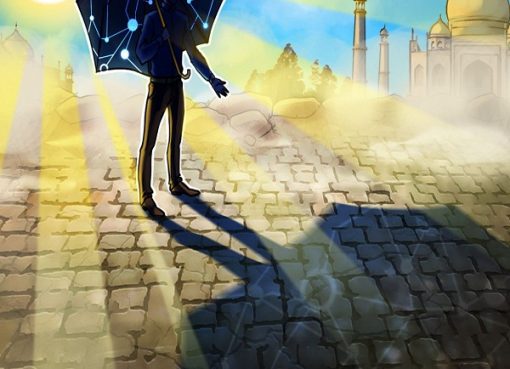Pinkerton: is there life on the moon? There is now. In April, we learned that an Israeli spacecraft, an unmanned 1290-lb lunar lander, had hard-crashed, not soft-landed, on the moon. These things happen; it’s not easy, after all, to make a soft landing on the lunar surface. In fact, only three countries—the U.S., Russia, and China—have managed that feat.
And yet, more recently, we’ve learned something particularly interesting about that crash-landing. According to The Times of Israel, the lander’s cargo included a population of tardigrades.
Tardigrades are tiny animals, related to crustaceans, a millimeter, or less, in size. They look a bit like caterpillars, only with eight legs. And yet, far more than even the toughest insect, tardigrades are remarkably rugged and hardy.
Tardigrades can survive in temperatures near the boiling point of water and near the absolute freezing point. You see, under stress, they can dehydrate themselves, entering into what’s known as a tun state. That is, they can mummify, shrinking down to a dry little kernel. Thus, they can survive years, even decades, without water, food, and air; indeed, during a period of tun status, they don’t even seem to age. And yet when their environment improves, tardigrades spring back to animated life. It’s no wonder, across planetary history, that tardigrades have survived five mass extinctions. They are, easily, the most indestructible multi-celled species on earth.
And now, too, perhaps, tardigrades are the first species to survive on the moon, thanks to that Israeli spacecraft, which was named, interestingly enough, Beresheet—that’s Hebrew for “Genesis.” Other earth-based biological organisms have come to the moon in prior landings over the last five decades, and yet, unless they were tardigrades, it’s unlikely that they still live. Only tardigrades seem to be able to survive, at least for a while, in outer space, and it helps that they can tolerate 1,000 times the radiation that would kill most other creatures.
No one knows for sure whether or not the tardigrades survived the impact on the moon, although the earth-based leader of the mission, Nova Spivack, says, “We believe the chances of survival for the tardigrades … are extremely high.”
Yet in the absence of firm facts, the imagination is free to wander. For instance, one imaginative soul, Caleb Watney, tweeted:
There’s a fun sci-fi book here …
The remnants of human civilization are on the run from an unknown alien menace. The big reveal is that they evolved from the tardigrades that crash-landed on the moon in 2019.
Interestingly, the news of the space-tardigrades comes at a time when the prospect for space-humans seems increasingly cloudy. Yes, we know how to build rockets and spacecraft, and robots, too—it’s people that are the weak link (although as an aside, retired U.S. Air Force Gen. Robert Spalding has warned that since we have outsourced so much of our technological know-how to China, it’s no longer clear that we could easily duplicate the Apollo 11 moon landing 50 years ago).
Yet beyond the issue of space-related hardware and software, there’s the issue of human “wetware.” That is, the flesh-and-blood bodies that would actually go into space. And in this realm, it’s clear that we simply don’t know how to keep humans healthy in a space environment over long periods of time.
That is, once space travel becomes more than a mission of just a few days, the ill-health effects of weightlessness and radiation, over longer periods of time, will become painfully obvious. In a nutshell, the human body was designed for gravity, and so, in the absence of gravity, muscles weaken, bones soften, brain fluid shifts, and eyeballs bulge. Yes, exercise and other fitness measures can help, and yet, the physical damage is apparent in the short term—and no one yet knows about the long term.
In fact, recently, it’s been possible to glean precise experiments on the near-term health impact of space travel, and astronaut Scott Kelly was the volunteer “guinea pig.” Kelly spent a year, from March 2015 to March 2016, aboard the International Space Station, and when he returned to earth, his physical status was compared to that of his identical twin brother, Mark Kelly; scientists found that Scott had suffered, according to National Geographic, from various forms of subtle damage, including thickening of his retina and his carotid artery, “inversions and translocations in his chromosomes,” and damage to his DNA. Additional reports have told of cognitive decline, as well as curious changes in Kelly’s gut bacteria.
To be sure, these health effects might not seem that bad—and, at least so far, there’s no shortage of would-be astronauts.
Yet still, some sober voices assert that humans will never flourish off-earth. Notably, the tech-oriented site Gizmodo recently bannered the headline “Humans will never colonize Mars.” In the words of author George Dvorsky:
The Red Planet is a cold, dead place, with an atmosphere about 100 times thinner than Earth’s. The paltry amount of air that does exist on Mars is primarily composed of noxious carbon dioxide, which does little to protect the surface from the Sun’s harmful rays. Air pressure on Mars is very low; at 600 Pascals, it’s only about 0.6 percent that of Earth. You might as well be exposed to the vacuum of space, resulting in a severe form of the bends—including ruptured lungs, dangerously swollen skin and body tissue, and ultimately death. The thin atmosphere also means that heat cannot be retained at the surface. The average temperature on Mars is -81 degrees Fahrenheit, with temperatures dropping as low as -195 degrees F.
In other words, being on Mars is like being atop Mt. Everest—only worse. Nor do a lot of people want to live atop Mt. Everest. Moreover, while civilization isn’t far from Everest, Mars is never closer than 34 million miles from Earth.
So will people really want to go to Mars to visit, spending months being irradiated in space? And will they wish to colonize and settle on Mars, with all its terrible rigors? Dvorsky says no, or, at least, not for long.
Of course, one should never underestimate the determination of human beings to dream great dreams and achieve heroic deeds. As the U.S. Navy Seabees, those construction lions of World War II and since, like to say, “The difficult we do now; the impossible takes a little longer.” And so, today, Elon Musk, to name one tech visionary, says he looks forward to dying on Mars, albeit not on impact. And Jeff Bezos says that he aims to spread one trillion (not a typo) people around the solar system.
Of course, as with the Seabees, Musk, and Bezos, doing the impossible is more than just a matter of grit and courage; it’s also a matter of brains and imagination. So we’ll need all those attributes—grit, courage, brains, imagination—to figure out how to survive and thrive in space, as well as on the moon or Mars, for long periods of time.
And as we have seen, survival entails more than just a thicker space suit—as if one could expect to wear that all the time in a hostile environment.
Thus, we come back to our hardy tiny friend, the tardigrade. Specifically, scientists are already wondering, what does the tardigrade know about survival in harsh climes that we humans, too, should know? If it can survive by entering a tun status—that is, mummifying at will—is that something humans could mimic? To be sure, mummification doesn’t sound pleasant, but it beats being frozen or zapped to death. Moreover, if tun/mummification has the effect of stopping time for the organism, well, that could come in handy on long space voyages.
Maybe there’s some sort of human-tardigrade fusion that could be achieved. And since we’ve already touched on sci-fi imagination, we can note that such classic works as the H.G. Wells novel The Island of Dr. Moreau and the Hollywood movie(s) The Fly touch on some element of man-animal fusion. Heck, there’s a whole Wikipedia page devoted to such hypothetical hybridization.
In fact, someone has already thought up the idea of blending humans and tardigrades for the sake of space survivability—and even made a video game of it.
No matter how dangerous it is, human beings will never give up on their quest for exploration and adventure. Moreover, given the fabulous wealth of the universe—a single asteroid, relatively close to the earth, is said to contain $20 trillion worth of cobalt, iron, and nickel—space travel will ultimately be lucrative, as well as exciting and epic. In other words, people will always have plenty of reasons to go–if they possibly can.
So while no one wants to be a tardigrade, the mimicking, or grafting, of tardigrade-y physical traits and features might be a small price to pay for the ability to safely zoom around space, around the solar system, and beyond.
Yes, it’s possible that we homo sapiens will soon be joined by a space-friendly version of ourselves, inspired by, or perhaps even borrowed from, the tardigrades: we might come to call this new being, perhaps, homo gradens.
The resulting creature might not be pretty. It would, indeed, be a far cry from the image of dashing spacemen, such as Buck Rogers or Captain Kirk. And yet, in terms of actual spacefaring, homo gradens just might get the job done.
Source: breitbart










